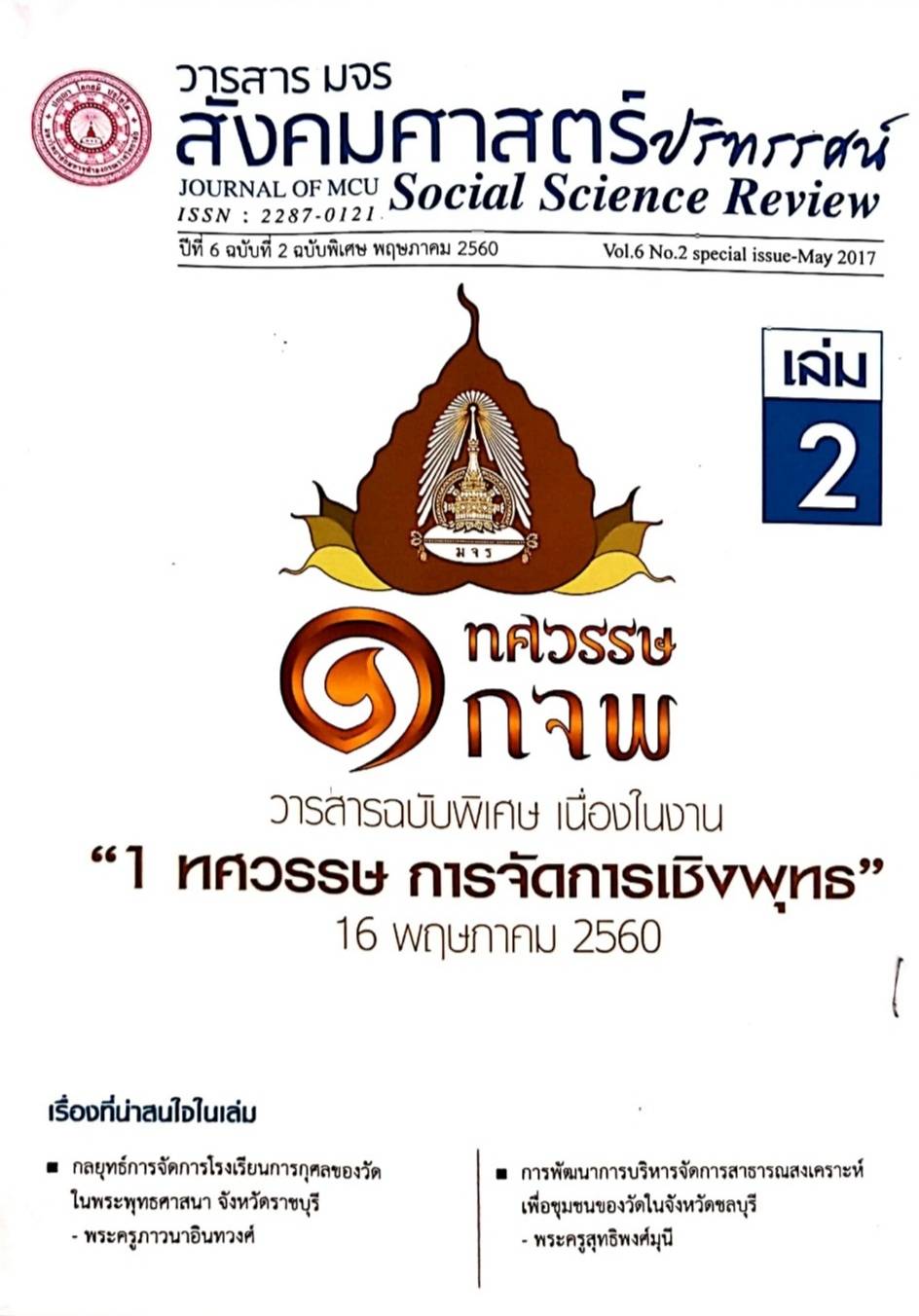การพัฒนาหลักสูตรเสริมเพื่อเสริมสร้างความสามารถในการรู้สารสนเทศ ตามแนวคิดการเรียนรู้แบบผสมผสานและการเรียนรู้โดยใช้สมองเป็นฐาน สำหรับนักเรียนระดับมัธยมศึกษาตอนปลาย
คำสำคัญ:
หลักสูตรเสริม, ความสามารถในการรู้สารสนเทศ, การเรียนรู้แบบผสมผสาน, การเรียนรู้โดยใช้สมองเป็นฐานบทคัดย่อ
การวิจัยครั้งนี้มีความมุ่งหมายเพื่อ 1) ศึกษามาตรฐานและตัวชี้วัดของการรู้สารสนเทศ 2) พัฒนาหลักสูตรเสริมเพื่อเสริมสร้างความสามารถในการรู้สารสนเทศตามแนวคิดการเรียนรู้แบบผสมผสานและการเรียนรู้โดยใช้สมองเป็นฐานสาหรับนักเรียนระดับมัธยมศึกษาตอนปลาย และ3) ศึกษาผลการทดลองใช้หลักสูตร กลุ่มตัวอย่างในการทดลองครั้งนี้ คือ นักเรียนระดับมัธยมศึกษาตอนปลายที่เป็นสมาชิกชุมนุมสารสนเทศ โรงเรียนบ้านนาคูพัฒนา “กรป.กลางอุปถัมภ์” สังกัดสำนักงานเขตพื้นที่การศึกษามัธยมศึกษา เขต 24 ปีการศึกษา 2559 จานวน 37 คน โดยเลือกแบบเจาะจง เครื่องมือที่ใช้ในการวิจัย ได้แก่ 1) แบบทดสอบความสามารถในการรู้สารสนเทศ และ 2)แบบประเมินความพึงพอใจ ดาเนินการทดลองแบบกลุ่มเดียวทดสอบก่อนและหลังการทดลอง สถิติที่ใช้ในการวิเคราะห์ข้อมูล ได้แก่ ค่าเฉลี่ย ค่าเบี่ยงเบนมาตรฐาน และค่าทดสอบทีผลการวิจัยพบว่า 1) มาตรฐานและตัวชี้วัดของการรู้สารสนเทศที่พัฒนาขึ้นมีคุณลักษณะที่ต้องการเสริมสร้างอยู่ในระดับมาก ประกอบด้วย 3 องค์ประกอบ ได้แก่ องค์ประกอบที่ 1ความสามารถด้านสารสนเทศพื้นฐาน ประกอบด้วย 2 มาตรฐาน 6 ตัวชี้วัด องค์ประกอบที่2 ความสามารถในการเรียนรู้ด้วยตนเอง ประกอบด้วย 2 มาตรฐาน 7 ตัวชี้วัด และองค์ประกอบที่ 3 ความรับผิดชอบต่อการใช้สารสนเทศในสังคม ประกอบด้วย 2 มาตรฐาน 5 ตัวชี้วัด2) องค์ประกอบของหลักสูตรมี 9 ประการ คือ ที่มาและความสาคัญ แนวคิดและทฤษฎีพื้นฐานหลักการ จุดมุ่งหมาย มาตรฐานและตัวชี้วัดของการรู้สารสนเทศ โครงสร้างเนื้อหา กระบวนการจัดกิจกรรมการเรียนรู้ สื่อและแหล่งเรียนรู้ และการวัดและประเมินผล 3) ผลการทดลองใช้หลักสูตรพบว่าความสามารถในการรู้สารสนเทศของนักเรียนหลังเรียนตามหลักสูตรสูงกว่าก่อนเรียนอย่างมีนัยสำคัญทางสถิติที่ระดับ .05 และผ่านเกณฑ์ร้อยละ 80 และความพึงพอใจของนักเรียนต่อการเรียนตามหลักสูตรอยู่ในระดับมาก
เอกสารอ้างอิง
มหาวิทยาลัยศรีนครินทรวิโรฒ.
ธำรง บัวศรี. (2542). ทฤษฎีหลักสูตร. กรุงเทพฯ: พัฒนาศึกษา.
นรีภัทร ผิวพอใช้. (2553). “การพัฒนาโมดูลชุดฝึกอบรมการส่งเสริมการรู้สารสนเทศตามลักษณะของกลุ่มผู้เรียนสำหรับนักศึกษาปริญญาบัณฑิต”. วิทยานิพนธ์ปริญญาปรัชญาดุษฎี
บัณฑิต. สาขาวิชาอุดมศึกษา ภาควิชานโยบายการจัดการและความเป็นผู้นำทางการศึกษา คณะครุศาสตร์ จุฬาลงกรณ์มหาวิทยาลัย.
บุญเลี้ยง ทุมทอง. (2553). การพัฒนาหลักสูตร Curriculum Development. กรุงเทพฯ:จุฬาลงกรณ์มหาวิทยาลัย.
วัลลยา ธรรมอภิบาล. (2555). “การพัฒนาหลักสูตรเสริมสร้างจิตสาธารณะ สาหรับนิสิตระดับปริญญาตรี มหาวิทยาลัยทักษิณ วิทยาเขตสงขลา”. วิทยานิพนธ์การศึกษาดุษฎีบัณฑิต. สาขาวิชาการวิจัยและพัฒนาหลักสูตร บัณฑิตวิทยาลัย มหาวิทยาลัยศรีนครินทรวิโรฒ.
สมพร หลิมเจริญ. (2552.) “การพัฒนาหลักสูตรเสริมเพื่อส่งเสริมความคิดสร้างสรรค์ สำหรับนักเรียนช่วงชั้นที่ 2”. วิทยานิพนธ์การศึกษาดุษฎีบัณฑิต. สาขาวิชาการวิจัยและพัฒนาหลักสูตร บัณฑิตวิทยาลัย มหาวิทยาลัยศรีนครินทรวิโรฒ.
สำนักงานเลขาธิการสภาการศึกษา. (2550). การจัดการเรียนรู้แบบกระบวนการแก้ปัญหา.กรุงเทพฯ: สานักงานเลขาธิการสภาการศึกษา.
สุจิตรา เขียวศรี. (2550).“การพัฒนารูปแบบการเรียนการสอนแบบสืบสอบบนเว็บวิชาวิทยาศาสตร์ โดยใช้การช่วยเสริมศักยภาพเพื่อพัฒนาทักษะการแก้ไขปัญหาของนักเรียนมัธยม ศึกษาตอนต้น”. วิทยานิพนธ์ครุศาสตร์ดุษฎีบัณฑิต. สาขาวิชาหลักสูตร และการสอน. บัณฑิตวิทยาลัย : จุฬาลงกรณ์มหาวิทยาลัย.
ศรีสมพร จันทะเลิศ. (2549). “การเปรียบเทียบผลการเรียนรู้ เรื่องเทคโนโลยีสารสนเทศ กลุ่มสาระ การเรียนรู้การงานอาชีพและเทคโนโลยี ชั้นประถมศึกษาปีที่ 4 ระหว่างการเรียนด้วยบทเรียนคอมพิวเตอร์ประกอบการจัดกิจกรรมการเรียนรู้แบบโครงงานกับ
การเรียนตามคู่มือครู”. วิทยานิพนธ์การศึกษามหาบัณฑิต. สาขาวิชาเทคโนโลยีทางการศึกษา. บัณฑิตวิทยาลัย : มหาวิทยาลัยมหาสารคาม.
อรอนงค์ นิยมธรรม. (2555). “การพัฒนาหลักสูตรเสริมสร้างคุณลักษณะด้านความเมตตากรุณาตามแนวคิดทฤษฎีการเรียนรู้เพื่อการเปลี่ยนแปลง สาหรับนักศึกษามหาวิทยาลัย
เทคโนโลยีราชมงคลล้านนา”. วิทยานิพนธ์การศึกษาดุษฎีบัณฑิต. สาขาวิชาการวิจัยและพัฒนาหลักสูตร บัณฑิตวิทยาลัย มหาวิทยาลัยศรีนครินทรวิโรฒ.
American Association of School Libraries: AASL. (1998). Information Power: The Nine Information Literacy Standards for Student Learning. Retrieved November 19. 1998. from http://www.ala.org/ip_nine.html. p. 79.
Council of Australian State Libraries. (2006) Information Literacy Standards.Camberra: Council of Austalian University Librarians.
Davis. Garry.A. & Rimm. Sylvia B. (1994). Education of Gifted and Talented 3rd ed.Boston: Allyn and Bacon.
ดาวน์โหลด
เผยแพร่แล้ว
รูปแบบการอ้างอิง
ฉบับ
ประเภทบทความ
สัญญาอนุญาต
ลิขสิทธิ์ (c) 2020 วารสาร มจร สังคมศาสตร์ปริทรรศน์

อนุญาตภายใต้เงื่อนไข Creative Commons Attribution-NonCommercial-NoDerivatives 4.0 International License.
เพื่อให้เป็นไปตามกฎหมายลิขสิทธิ์ ผู้นิพนธ์ทุกท่านต้องลงลายมือชื่อในแบบฟอร์มใบมอบลิขสิทธิ์บทความให้แก่วารสารฯ พร้อมกับบทความต้นฉบับที่ได้แก้ไขครั้งสุดท้าย นอกจากนี้ ผู้นิพนธ์ทุกท่านต้องยืนยันว่าบทความต้นฉบับที่ส่งมาตีพิมพ์นั้น ได้ส่งมาตีพิมพ์เฉพาะในวารสาร มจร สังคมศาสตร์ปริทรรศน์ เพียงแห่งเดียวเท่านั้น หากมีการใช้ภาพหรือตารางหรือเนื้อหาอื่นๆ ของผู้นิพนธ์อื่นที่ปรากฏในสิ่งตีพิมพ์อื่นมาแล้ว ผู้นิพนธ์ต้องขออนุญาตเจ้าของลิขสิทธิ์ก่อน พร้อมทั้งแสดงหนังสือที่ได้รับการยินยอมต่อบรรณาธิการ ก่อนที่บทความจะได้รับการตีพิมพ์ หากไม่เป็นไปตามข้อกำหนดเบื้องต้น ทางวารสารจะถอดบทความของท่านออกโดยไม่มีข้อยกเว้นใดๆ ทั้งสิ้น





